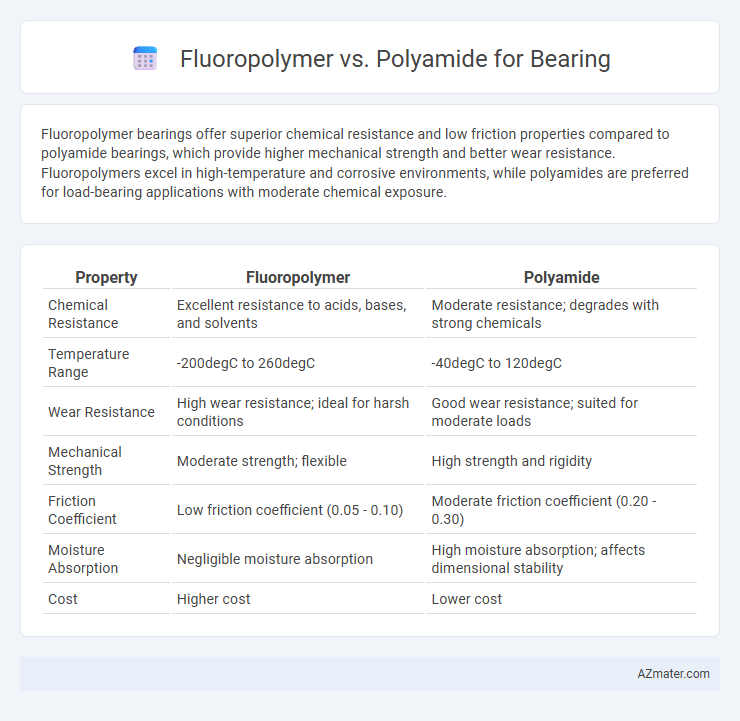Fluoropolymer bearings offer superior chemical resistance and low friction properties compared to polyamide bearings, which provide higher mechanical strength and better wear resistance. Fluoropolymers excel in high-temperature and corrosive environments, while polyamides are preferred for load-bearing applications with moderate chemical exposure.
Table of Comparison
| Property | Fluoropolymer | Polyamide |
|---|---|---|
| Chemical Resistance | Excellent resistance to acids, bases, and solvents | Moderate resistance; degrades with strong chemicals |
| Temperature Range | -200degC to 260degC | -40degC to 120degC |
| Wear Resistance | High wear resistance; ideal for harsh conditions | Good wear resistance; suited for moderate loads |
| Mechanical Strength | Moderate strength; flexible | High strength and rigidity |
| Friction Coefficient | Low friction coefficient (0.05 - 0.10) | Moderate friction coefficient (0.20 - 0.30) |
| Moisture Absorption | Negligible moisture absorption | High moisture absorption; affects dimensional stability |
| Cost | Higher cost | Lower cost |
Introduction to Fluoropolymer and Polyamide Bearings
Fluoropolymer bearings offer exceptional chemical resistance, low friction, and high thermal stability, making them ideal for harsh environments and applications requiring minimal lubrication. Polyamide bearings, known for their toughness, wear resistance, and self-lubricating properties, provide a cost-effective solution for moderate load and speed conditions. Comparing fluoropolymer and polyamide bearings highlights differences in chemical inertness, temperature tolerance, and mechanical durability essential for selecting the right material in industrial applications.
Key Properties of Fluoropolymer Bearings
Fluoropolymer bearings offer exceptional chemical resistance, low friction coefficients, and outstanding thermal stability up to 260degC, making them ideal for harsh environments. Their non-stick surface reduces wear and extends service life, outperforming polyamide bearings in corrosion and high-temperature applications. Compared to polyamide, fluoropolymer bearings deliver superior dimensional stability, enhanced resistance to aggressive chemicals, and lower moisture absorption.
Essential Characteristics of Polyamide Bearings
Polyamide bearings offer high mechanical strength, excellent wear resistance, and superior fatigue endurance, making them ideal for dynamic load applications. Their inherent self-lubricating properties reduce friction and maintenance requirements compared to fluoropolymer bearings, which excel in chemical resistance but lack comparable load-bearing capacity. Polyamide's resistance to moisture absorption and dimensional stability under varying temperatures ensure consistent performance in demanding industrial environments.
Comparative Mechanical Strength
Fluoropolymers exhibit excellent chemical resistance and low friction but generally have lower tensile strength and modulus compared to polyamides, which offer superior mechanical strength and load-bearing capacity in bearing applications. Polyamide bearings provide higher impact resistance and dimensional stability under mechanical stress, making them suitable for demanding structural uses. The inherent toughness and rigidity of polyamides support enhanced wear resistance, while fluoropolymers excel in environments requiring chemical inertness and lubrication.
Chemical Resistance: Fluoropolymer vs Polyamide
Fluoropolymers exhibit superior chemical resistance compared to polyamides, maintaining structural integrity when exposed to aggressive solvents, acids, and bases. Polyamide bearings are prone to hydrolysis and degradation in strong chemical environments, leading to reduced lifespan and performance. Fluoropolymer materials like PTFE provide exceptional resistance to a broad spectrum of chemicals, making them ideal for applications requiring high durability in harsh chemical conditions.
Temperature Tolerance and Thermal Stability
Fluoropolymer bearings exhibit superior temperature tolerance, withstanding continuous operating temperatures up to 260degC, compared to polyamide bearings, which typically endure temperatures up to 120degC. The exceptional thermal stability of fluoropolymers results from their strong carbon-fluorine bonds, enabling resistance to thermal degradation and chemical exposure. In contrast, polyamide bearings degrade faster under high heat and prolonged thermal stress, limiting their application in high-temperature environments.
Wear and Friction Performance
Fluoropolymer bearings exhibit superior wear resistance and lower friction coefficients compared to polyamide bearings, making them ideal for high-performance, low-maintenance applications. The inherent chemical inertness and self-lubricating properties of fluoropolymers significantly reduce wear rates, enhancing bearing lifespan under challenging conditions. In contrast, polyamide bearings, while offering good mechanical strength, tend to experience higher friction and accelerated wear in abrasive or high-temperature environments.
Applications and Industry Use Cases
Fluoropolymer bearings excel in chemical resistance, high-temperature tolerance, and low friction, making them ideal for harsh environments such as chemical processing, food manufacturing, and pharmaceutical industries. Polyamide bearings offer superior mechanical strength, impact resistance, and cost-effectiveness, commonly used in automotive, textile machinery, and consumer electronics. Industry use cases for fluoropolymer bearings include corrosive fluid pumps and cleanroom equipment, while polyamide bearings are preferred for general-purpose gears, conveyors, and lightweight structural components.
Cost-Effectiveness and Longevity
Fluoropolymer bearings offer superior chemical resistance and low friction, resulting in extended service life and reduced maintenance costs compared to polyamide bearings. Polyamide bearings are generally more cost-effective upfront with good wear resistance but may degrade faster under harsh environmental conditions, leading to more frequent replacements. Evaluating the total cost of ownership favors fluoropolymers in applications requiring long-term durability and high-performance stability.
Choosing the Right Material for Your Bearing Needs
Fluoropolymer bearings offer exceptional chemical resistance, low friction, and high-temperature tolerance, making them ideal for harsh environments and applications requiring minimal lubrication. Polyamide bearings provide strength, impact resistance, and cost-effectiveness, suitable for moderate loads and less aggressive conditions. Selecting the right bearing material depends on analyzing operating temperature, chemical exposure, load capacity, and maintenance requirements to ensure optimal performance and longevity.

Infographic: Fluoropolymer vs Polyamide for Bearing
 azmater.com
azmater.com